Strategic Marketing Plan for Co-op Food in Digital Economy (BUSM 4302)
VerifiedAdded on 2023/01/13
|15
|3548
|99
Report
AI Summary
This report presents a comprehensive marketing plan for Co-op Food, focusing on acquiring customers through pricing, sales, and online branding within the digital economy. Employing the SOSTAC planning system, the plan includes a detailed situational analysis, SWOT analysis, and identifies objectives to increase brand awareness, sales, and market share. Targeting the younger generation through market segmentation, the plan recommends tactics such as market penetration and value-based pricing strategies, alongside a strong emphasis on leveraging earned media for digital branding to overcome the limitations of owned media. The report outlines specific actions and control measures to ensure effective implementation and achieve the stated objectives, providing a strategic roadmap for Co-op Food's success in the competitive UK convenience store market.
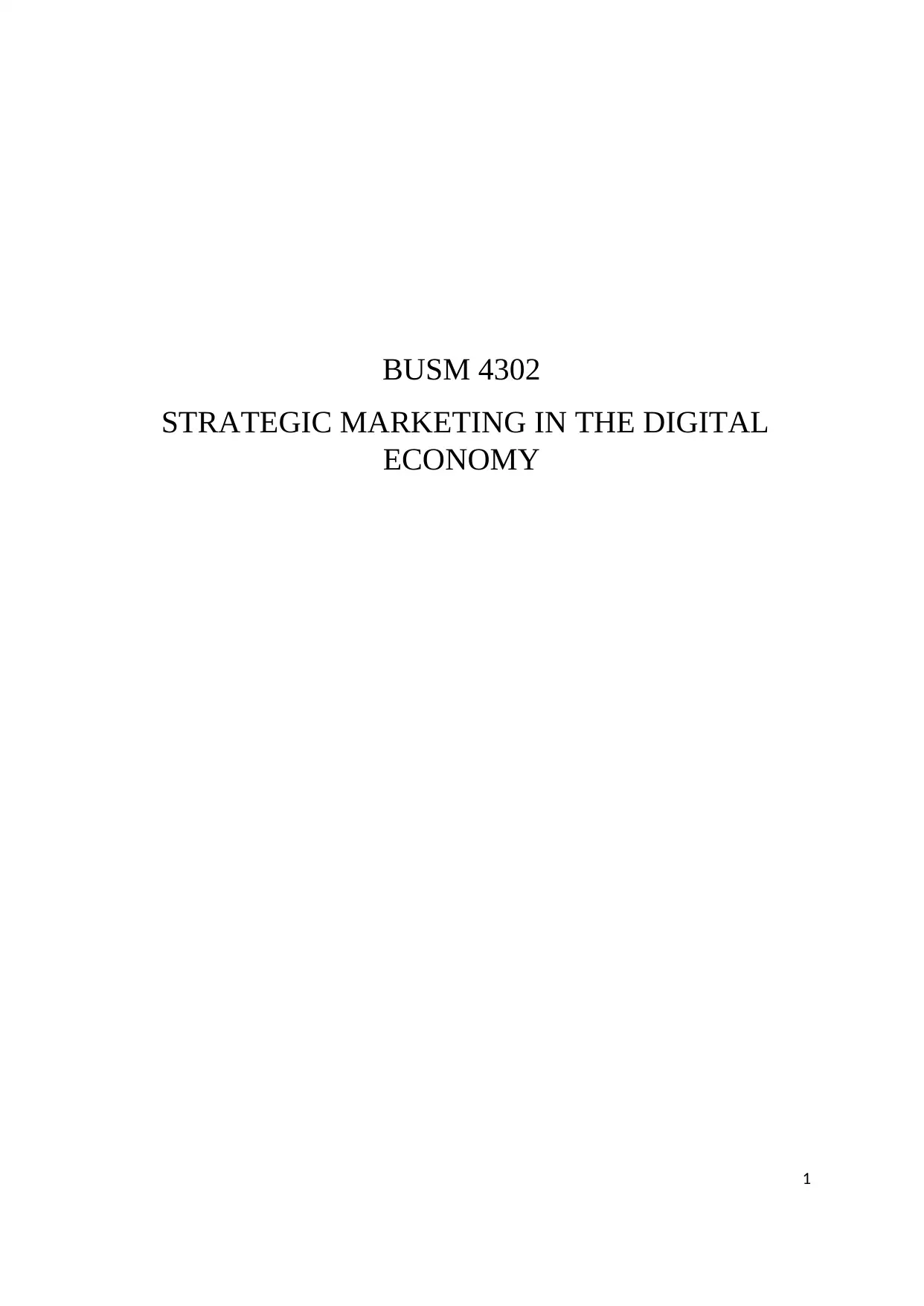
BUSM 4302
STRATEGIC MARKETING IN THE DIGITAL
ECONOMY
1
STRATEGIC MARKETING IN THE DIGITAL
ECONOMY
1
Paraphrase This Document
Need a fresh take? Get an instant paraphrase of this document with our AI Paraphraser
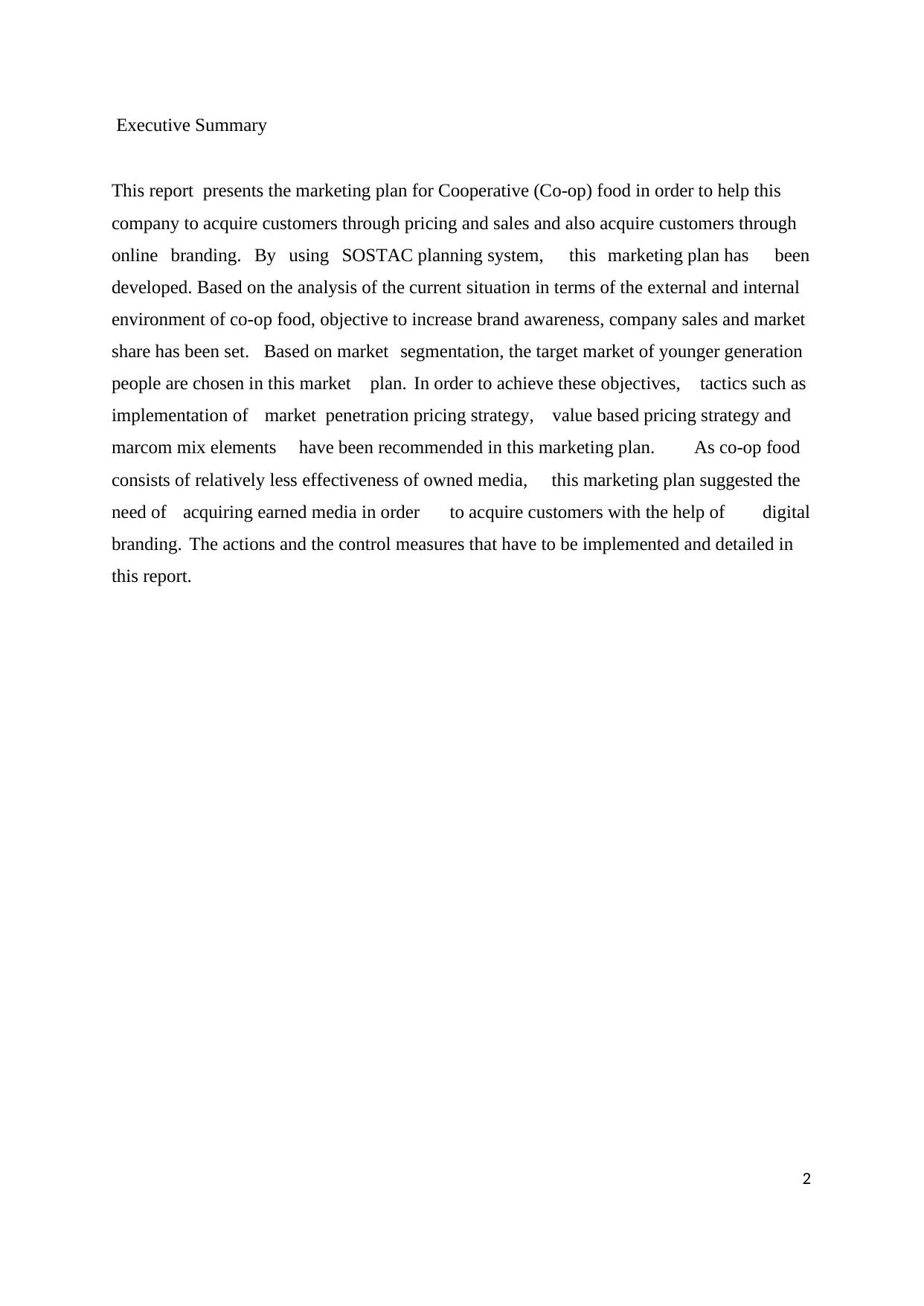
Executive Summary
This report presents the marketing plan for Cooperative (Co-op) food in order to help this
company to acquire customers through pricing and sales and also acquire customers through
online branding. By using SOSTAC planning system, this marketing plan has been
developed. Based on the analysis of the current situation in terms of the external and internal
environment of co-op food, objective to increase brand awareness, company sales and market
share has been set. Based on market segmentation, the target market of younger generation
people are chosen in this market plan. In order to achieve these objectives, tactics such as
implementation of market penetration pricing strategy, value based pricing strategy and
marcom mix elements have been recommended in this marketing plan. As co-op food
consists of relatively less effectiveness of owned media, this marketing plan suggested the
need of acquiring earned media in order to acquire customers with the help of digital
branding. The actions and the control measures that have to be implemented and detailed in
this report.
2
This report presents the marketing plan for Cooperative (Co-op) food in order to help this
company to acquire customers through pricing and sales and also acquire customers through
online branding. By using SOSTAC planning system, this marketing plan has been
developed. Based on the analysis of the current situation in terms of the external and internal
environment of co-op food, objective to increase brand awareness, company sales and market
share has been set. Based on market segmentation, the target market of younger generation
people are chosen in this market plan. In order to achieve these objectives, tactics such as
implementation of market penetration pricing strategy, value based pricing strategy and
marcom mix elements have been recommended in this marketing plan. As co-op food
consists of relatively less effectiveness of owned media, this marketing plan suggested the
need of acquiring earned media in order to acquire customers with the help of digital
branding. The actions and the control measures that have to be implemented and detailed in
this report.
2
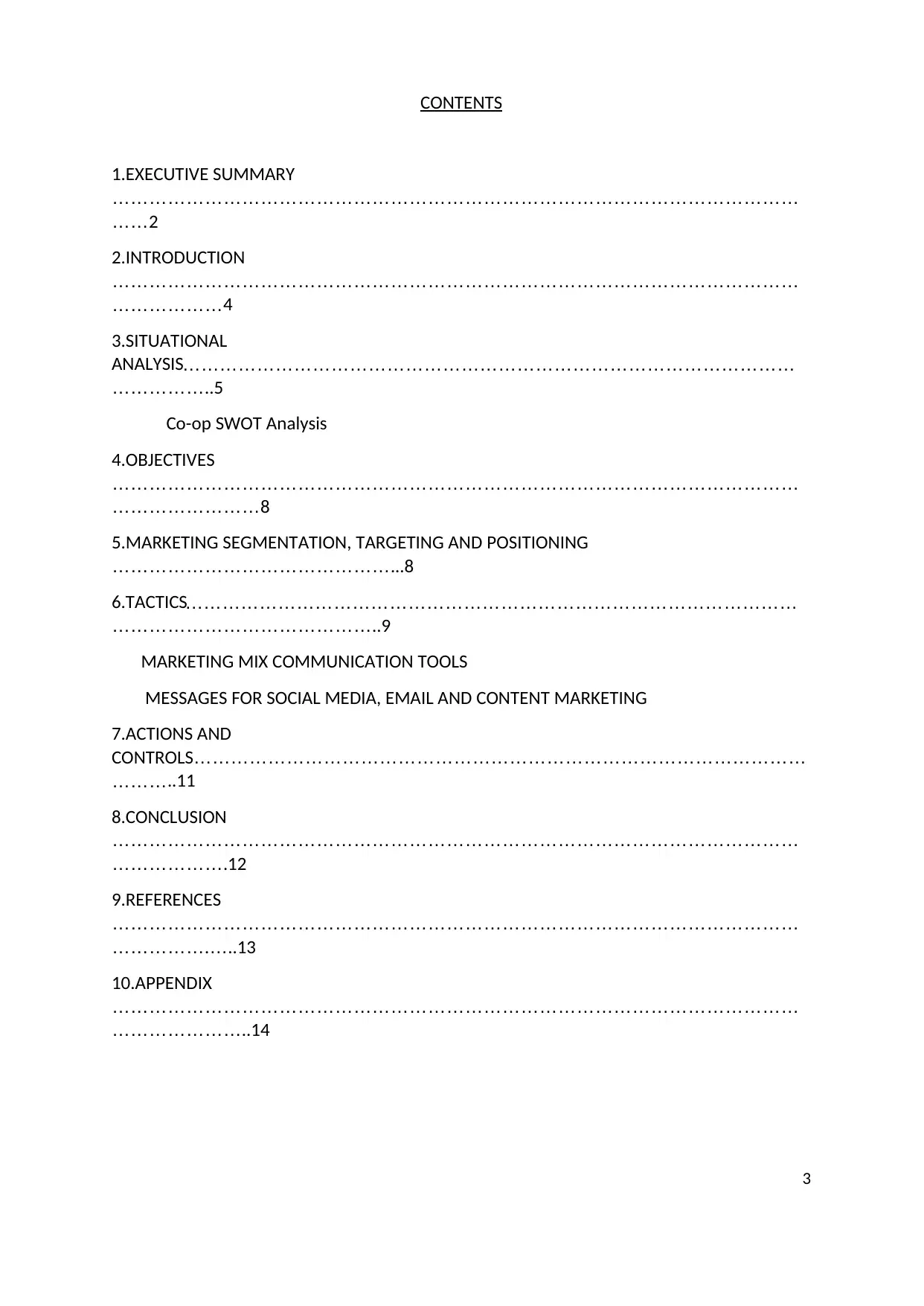
CONTENTS
1.EXECUTIVE SUMMARY
…………………………………………………………………………………………………
……2
2.INTRODUCTION
…………………………………………………………………………………………………
………………4
3.SITUATIONAL
ANALYSIS………………………………………………………………………………………
……………..5
Co-op SWOT Analysis
4.OBJECTIVES
…………………………………………………………………………………………………
……………………8
5.MARKETING SEGMENTATION, TARGETING AND POSITIONING
………………………………………...8
6.TACTICS………………………………………………………………………………………
……………………………………..9
MARKETING MIX COMMUNICATION TOOLS
MESSAGES FOR SOCIAL MEDIA, EMAIL AND CONTENT MARKETING
7.ACTIONS AND
CONTROLS………………………………………………………………………………………
………..11
8.CONCLUSION
…………………………………………………………………………………………………
……………….12
9.REFERENCES
…………………………………………………………………………………………………
…………….…..13
10.APPENDIX
…………………………………………………………………………………………………
…………………..14
3
1.EXECUTIVE SUMMARY
…………………………………………………………………………………………………
……2
2.INTRODUCTION
…………………………………………………………………………………………………
………………4
3.SITUATIONAL
ANALYSIS………………………………………………………………………………………
……………..5
Co-op SWOT Analysis
4.OBJECTIVES
…………………………………………………………………………………………………
……………………8
5.MARKETING SEGMENTATION, TARGETING AND POSITIONING
………………………………………...8
6.TACTICS………………………………………………………………………………………
……………………………………..9
MARKETING MIX COMMUNICATION TOOLS
MESSAGES FOR SOCIAL MEDIA, EMAIL AND CONTENT MARKETING
7.ACTIONS AND
CONTROLS………………………………………………………………………………………
………..11
8.CONCLUSION
…………………………………………………………………………………………………
……………….12
9.REFERENCES
…………………………………………………………………………………………………
…………….…..13
10.APPENDIX
…………………………………………………………………………………………………
…………………..14
3
⊘ This is a preview!⊘
Do you want full access?
Subscribe today to unlock all pages.

Trusted by 1+ million students worldwide
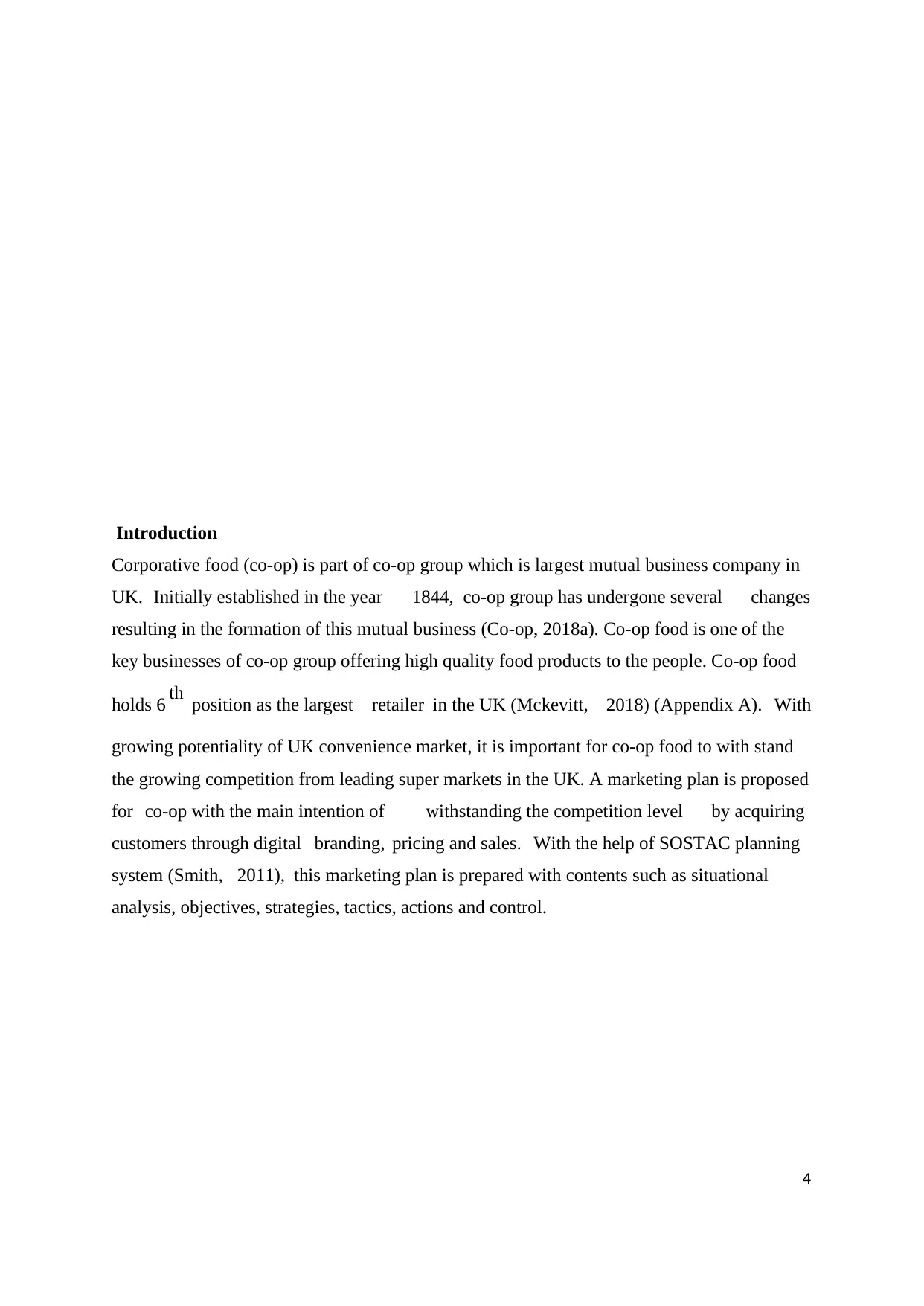
Introduction
Corporative food (co-op) is part of co-op group which is largest mutual business company in
UK. Initially established in the year 1844, co-op group has undergone several changes
resulting in the formation of this mutual business (Co-op, 2018a). Co-op food is one of the
key businesses of co-op group offering high quality food products to the people. Co-op food
holds 6 th position as the largest retailer in the UK (Mckevitt, 2018) (Appendix A). With
growing potentiality of UK convenience market, it is important for co-op food to with stand
the growing competition from leading super markets in the UK. A marketing plan is proposed
for co-op with the main intention of withstanding the competition level by acquiring
customers through digital branding, pricing and sales. With the help of SOSTAC planning
system (Smith, 2011), this marketing plan is prepared with contents such as situational
analysis, objectives, strategies, tactics, actions and control.
4
Corporative food (co-op) is part of co-op group which is largest mutual business company in
UK. Initially established in the year 1844, co-op group has undergone several changes
resulting in the formation of this mutual business (Co-op, 2018a). Co-op food is one of the
key businesses of co-op group offering high quality food products to the people. Co-op food
holds 6 th position as the largest retailer in the UK (Mckevitt, 2018) (Appendix A). With
growing potentiality of UK convenience market, it is important for co-op food to with stand
the growing competition from leading super markets in the UK. A marketing plan is proposed
for co-op with the main intention of withstanding the competition level by acquiring
customers through digital branding, pricing and sales. With the help of SOSTAC planning
system (Smith, 2011), this marketing plan is prepared with contents such as situational
analysis, objectives, strategies, tactics, actions and control.
4
Paraphrase This Document
Need a fresh take? Get an instant paraphrase of this document with our AI Paraphraser
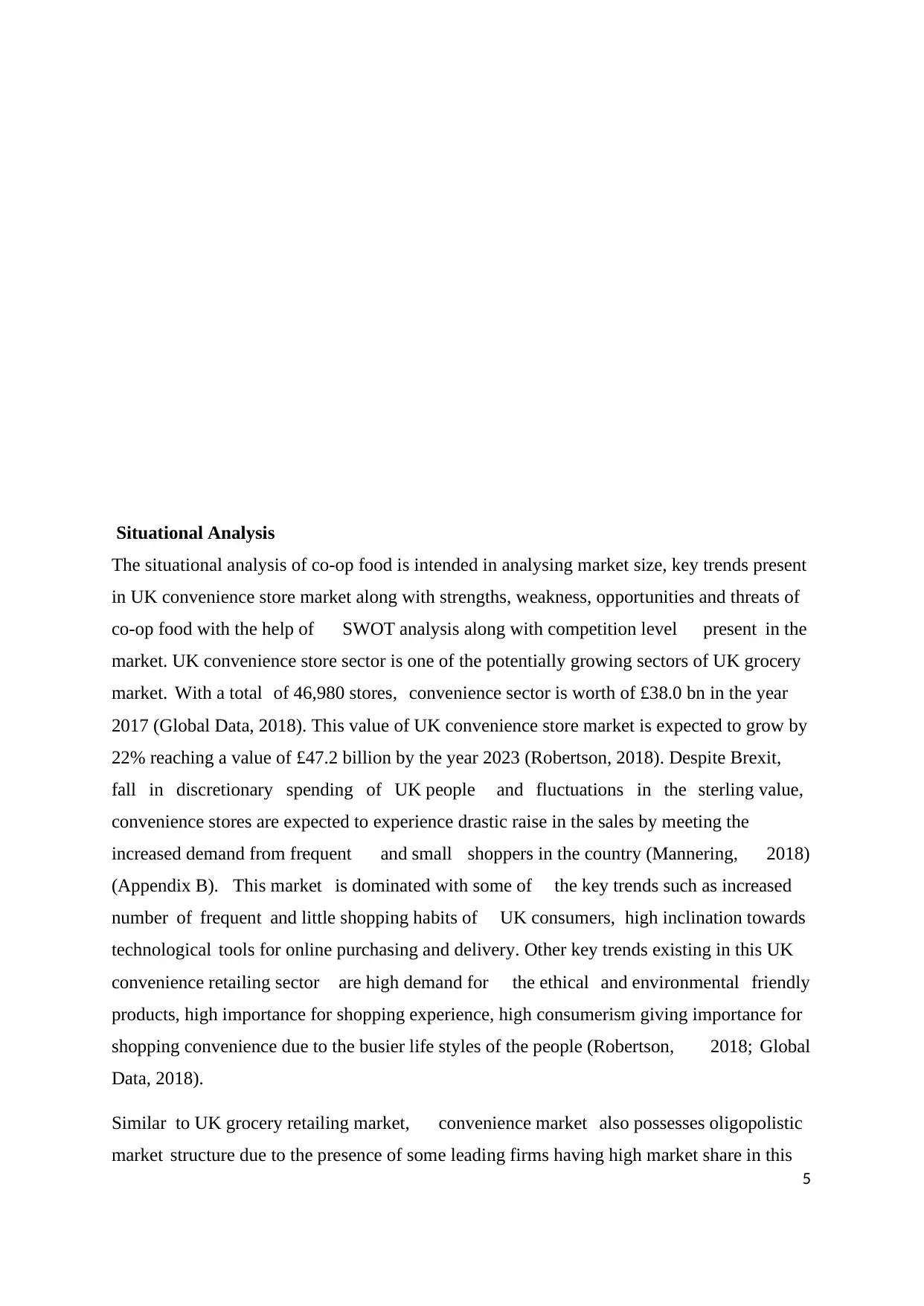
Situational Analysis
The situational analysis of co-op food is intended in analysing market size, key trends present
in UK convenience store market along with strengths, weakness, opportunities and threats of
co-op food with the help of SWOT analysis along with competition level present in the
market. UK convenience store sector is one of the potentially growing sectors of UK grocery
market. With a total of 46,980 stores, convenience sector is worth of £38.0 bn in the year
2017 (Global Data, 2018). This value of UK convenience store market is expected to grow by
22% reaching a value of £47.2 billion by the year 2023 (Robertson, 2018). Despite Brexit,
fall in discretionary spending of UK people and fluctuations in the sterling value,
convenience stores are expected to experience drastic raise in the sales by meeting the
increased demand from frequent and small shoppers in the country (Mannering, 2018)
(Appendix B). This market is dominated with some of the key trends such as increased
number of frequent and little shopping habits of UK consumers, high inclination towards
technological tools for online purchasing and delivery. Other key trends existing in this UK
convenience retailing sector are high demand for the ethical and environmental friendly
products, high importance for shopping experience, high consumerism giving importance for
shopping convenience due to the busier life styles of the people (Robertson, 2018; Global
Data, 2018).
Similar to UK grocery retailing market, convenience market also possesses oligopolistic
market structure due to the presence of some leading firms having high market share in this
5
The situational analysis of co-op food is intended in analysing market size, key trends present
in UK convenience store market along with strengths, weakness, opportunities and threats of
co-op food with the help of SWOT analysis along with competition level present in the
market. UK convenience store sector is one of the potentially growing sectors of UK grocery
market. With a total of 46,980 stores, convenience sector is worth of £38.0 bn in the year
2017 (Global Data, 2018). This value of UK convenience store market is expected to grow by
22% reaching a value of £47.2 billion by the year 2023 (Robertson, 2018). Despite Brexit,
fall in discretionary spending of UK people and fluctuations in the sterling value,
convenience stores are expected to experience drastic raise in the sales by meeting the
increased demand from frequent and small shoppers in the country (Mannering, 2018)
(Appendix B). This market is dominated with some of the key trends such as increased
number of frequent and little shopping habits of UK consumers, high inclination towards
technological tools for online purchasing and delivery. Other key trends existing in this UK
convenience retailing sector are high demand for the ethical and environmental friendly
products, high importance for shopping experience, high consumerism giving importance for
shopping convenience due to the busier life styles of the people (Robertson, 2018; Global
Data, 2018).
Similar to UK grocery retailing market, convenience market also possesses oligopolistic
market structure due to the presence of some leading firms having high market share in this
5
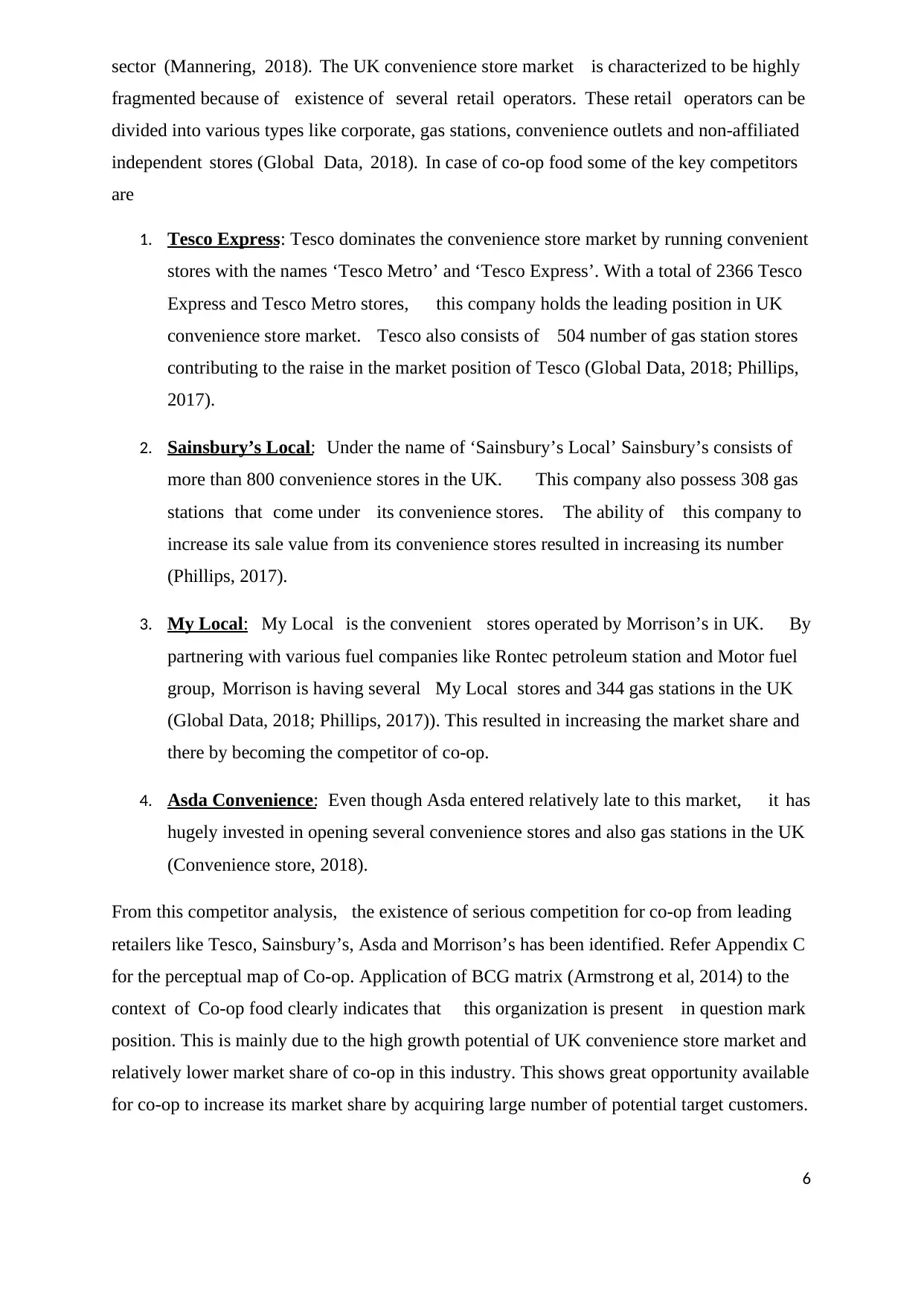
sector (Mannering, 2018). The UK convenience store market is characterized to be highly
fragmented because of existence of several retail operators. These retail operators can be
divided into various types like corporate, gas stations, convenience outlets and non-affiliated
independent stores (Global Data, 2018). In case of co-op food some of the key competitors
are
1. Tesco Express: Tesco dominates the convenience store market by running convenient
stores with the names ‘Tesco Metro’ and ‘Tesco Express’. With a total of 2366 Tesco
Express and Tesco Metro stores, this company holds the leading position in UK
convenience store market. Tesco also consists of 504 number of gas station stores
contributing to the raise in the market position of Tesco (Global Data, 2018; Phillips,
2017).
2. Sainsbury’s Local: Under the name of ‘Sainsbury’s Local’ Sainsbury’s consists of
more than 800 convenience stores in the UK. This company also possess 308 gas
stations that come under its convenience stores. The ability of this company to
increase its sale value from its convenience stores resulted in increasing its number
(Phillips, 2017).
3. My Local: My Local is the convenient stores operated by Morrison’s in UK. By
partnering with various fuel companies like Rontec petroleum station and Motor fuel
group, Morrison is having several My Local stores and 344 gas stations in the UK
(Global Data, 2018; Phillips, 2017)). This resulted in increasing the market share and
there by becoming the competitor of co-op.
4. Asda Convenience: Even though Asda entered relatively late to this market, it has
hugely invested in opening several convenience stores and also gas stations in the UK
(Convenience store, 2018).
From this competitor analysis, the existence of serious competition for co-op from leading
retailers like Tesco, Sainsbury’s, Asda and Morrison’s has been identified. Refer Appendix C
for the perceptual map of Co-op. Application of BCG matrix (Armstrong et al, 2014) to the
context of Co-op food clearly indicates that this organization is present in question mark
position. This is mainly due to the high growth potential of UK convenience store market and
relatively lower market share of co-op in this industry. This shows great opportunity available
for co-op to increase its market share by acquiring large number of potential target customers.
6
fragmented because of existence of several retail operators. These retail operators can be
divided into various types like corporate, gas stations, convenience outlets and non-affiliated
independent stores (Global Data, 2018). In case of co-op food some of the key competitors
are
1. Tesco Express: Tesco dominates the convenience store market by running convenient
stores with the names ‘Tesco Metro’ and ‘Tesco Express’. With a total of 2366 Tesco
Express and Tesco Metro stores, this company holds the leading position in UK
convenience store market. Tesco also consists of 504 number of gas station stores
contributing to the raise in the market position of Tesco (Global Data, 2018; Phillips,
2017).
2. Sainsbury’s Local: Under the name of ‘Sainsbury’s Local’ Sainsbury’s consists of
more than 800 convenience stores in the UK. This company also possess 308 gas
stations that come under its convenience stores. The ability of this company to
increase its sale value from its convenience stores resulted in increasing its number
(Phillips, 2017).
3. My Local: My Local is the convenient stores operated by Morrison’s in UK. By
partnering with various fuel companies like Rontec petroleum station and Motor fuel
group, Morrison is having several My Local stores and 344 gas stations in the UK
(Global Data, 2018; Phillips, 2017)). This resulted in increasing the market share and
there by becoming the competitor of co-op.
4. Asda Convenience: Even though Asda entered relatively late to this market, it has
hugely invested in opening several convenience stores and also gas stations in the UK
(Convenience store, 2018).
From this competitor analysis, the existence of serious competition for co-op from leading
retailers like Tesco, Sainsbury’s, Asda and Morrison’s has been identified. Refer Appendix C
for the perceptual map of Co-op. Application of BCG matrix (Armstrong et al, 2014) to the
context of Co-op food clearly indicates that this organization is present in question mark
position. This is mainly due to the high growth potential of UK convenience store market and
relatively lower market share of co-op in this industry. This shows great opportunity available
for co-op to increase its market share by acquiring large number of potential target customers.
6
⊘ This is a preview!⊘
Do you want full access?
Subscribe today to unlock all pages.

Trusted by 1+ million students worldwide
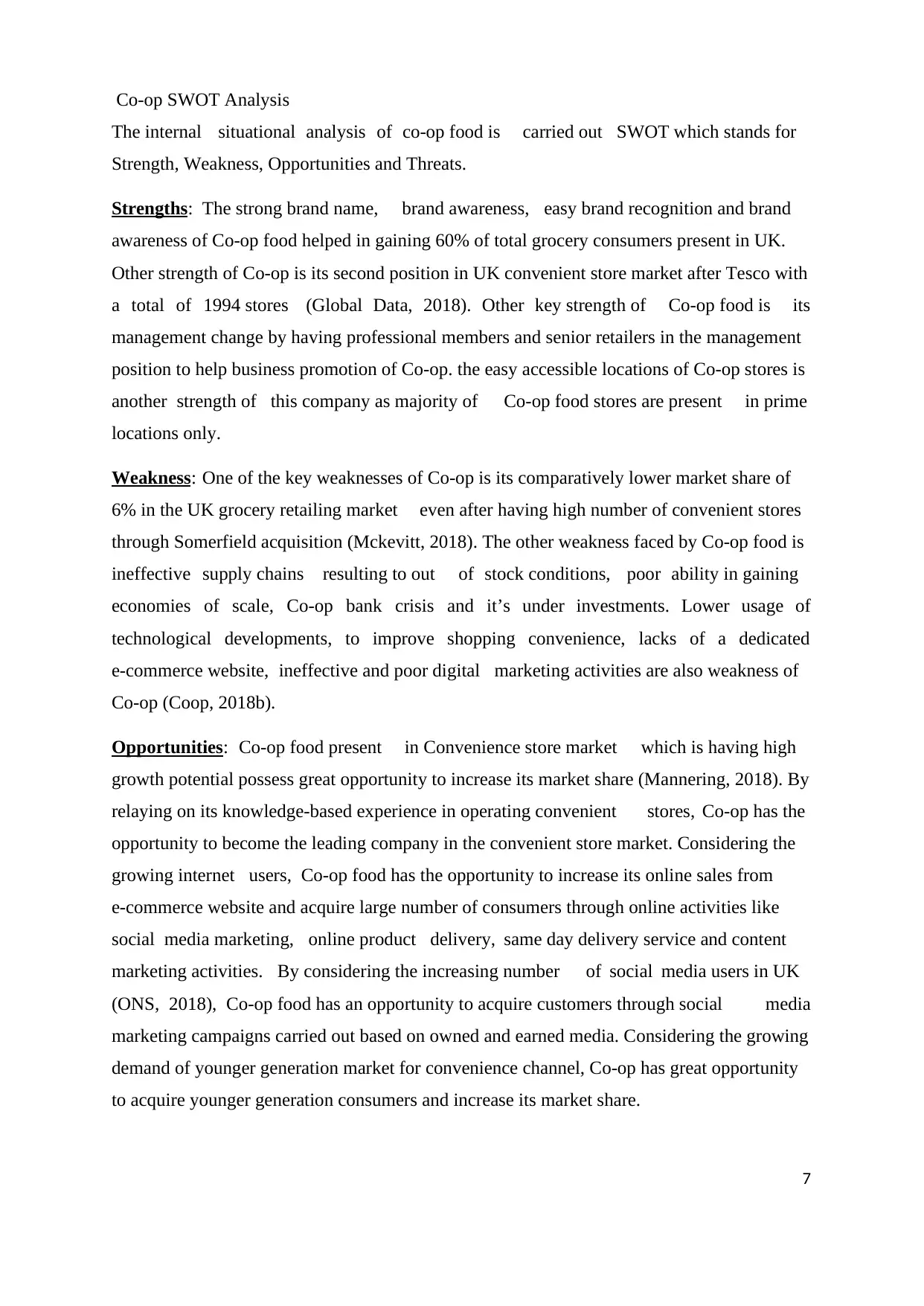
Co-op SWOT Analysis
The internal situational analysis of co-op food is carried out SWOT which stands for
Strength, Weakness, Opportunities and Threats.
Strengths: The strong brand name, brand awareness, easy brand recognition and brand
awareness of Co-op food helped in gaining 60% of total grocery consumers present in UK.
Other strength of Co-op is its second position in UK convenient store market after Tesco with
a total of 1994 stores (Global Data, 2018). Other key strength of Co-op food is its
management change by having professional members and senior retailers in the management
position to help business promotion of Co-op. the easy accessible locations of Co-op stores is
another strength of this company as majority of Co-op food stores are present in prime
locations only.
Weakness: One of the key weaknesses of Co-op is its comparatively lower market share of
6% in the UK grocery retailing market even after having high number of convenient stores
through Somerfield acquisition (Mckevitt, 2018). The other weakness faced by Co-op food is
ineffective supply chains resulting to out of stock conditions, poor ability in gaining
economies of scale, Co-op bank crisis and it’s under investments. Lower usage of
technological developments, to improve shopping convenience, lacks of a dedicated
e-commerce website, ineffective and poor digital marketing activities are also weakness of
Co-op (Coop, 2018b).
Opportunities: Co-op food present in Convenience store market which is having high
growth potential possess great opportunity to increase its market share (Mannering, 2018). By
relaying on its knowledge-based experience in operating convenient stores, Co-op has the
opportunity to become the leading company in the convenient store market. Considering the
growing internet users, Co-op food has the opportunity to increase its online sales from
e-commerce website and acquire large number of consumers through online activities like
social media marketing, online product delivery, same day delivery service and content
marketing activities. By considering the increasing number of social media users in UK
(ONS, 2018), Co-op food has an opportunity to acquire customers through social media
marketing campaigns carried out based on owned and earned media. Considering the growing
demand of younger generation market for convenience channel, Co-op has great opportunity
to acquire younger generation consumers and increase its market share.
7
The internal situational analysis of co-op food is carried out SWOT which stands for
Strength, Weakness, Opportunities and Threats.
Strengths: The strong brand name, brand awareness, easy brand recognition and brand
awareness of Co-op food helped in gaining 60% of total grocery consumers present in UK.
Other strength of Co-op is its second position in UK convenient store market after Tesco with
a total of 1994 stores (Global Data, 2018). Other key strength of Co-op food is its
management change by having professional members and senior retailers in the management
position to help business promotion of Co-op. the easy accessible locations of Co-op stores is
another strength of this company as majority of Co-op food stores are present in prime
locations only.
Weakness: One of the key weaknesses of Co-op is its comparatively lower market share of
6% in the UK grocery retailing market even after having high number of convenient stores
through Somerfield acquisition (Mckevitt, 2018). The other weakness faced by Co-op food is
ineffective supply chains resulting to out of stock conditions, poor ability in gaining
economies of scale, Co-op bank crisis and it’s under investments. Lower usage of
technological developments, to improve shopping convenience, lacks of a dedicated
e-commerce website, ineffective and poor digital marketing activities are also weakness of
Co-op (Coop, 2018b).
Opportunities: Co-op food present in Convenience store market which is having high
growth potential possess great opportunity to increase its market share (Mannering, 2018). By
relaying on its knowledge-based experience in operating convenient stores, Co-op has the
opportunity to become the leading company in the convenient store market. Considering the
growing internet users, Co-op food has the opportunity to increase its online sales from
e-commerce website and acquire large number of consumers through online activities like
social media marketing, online product delivery, same day delivery service and content
marketing activities. By considering the increasing number of social media users in UK
(ONS, 2018), Co-op food has an opportunity to acquire customers through social media
marketing campaigns carried out based on owned and earned media. Considering the growing
demand of younger generation market for convenience channel, Co-op has great opportunity
to acquire younger generation consumers and increase its market share.
7
Paraphrase This Document
Need a fresh take? Get an instant paraphrase of this document with our AI Paraphraser
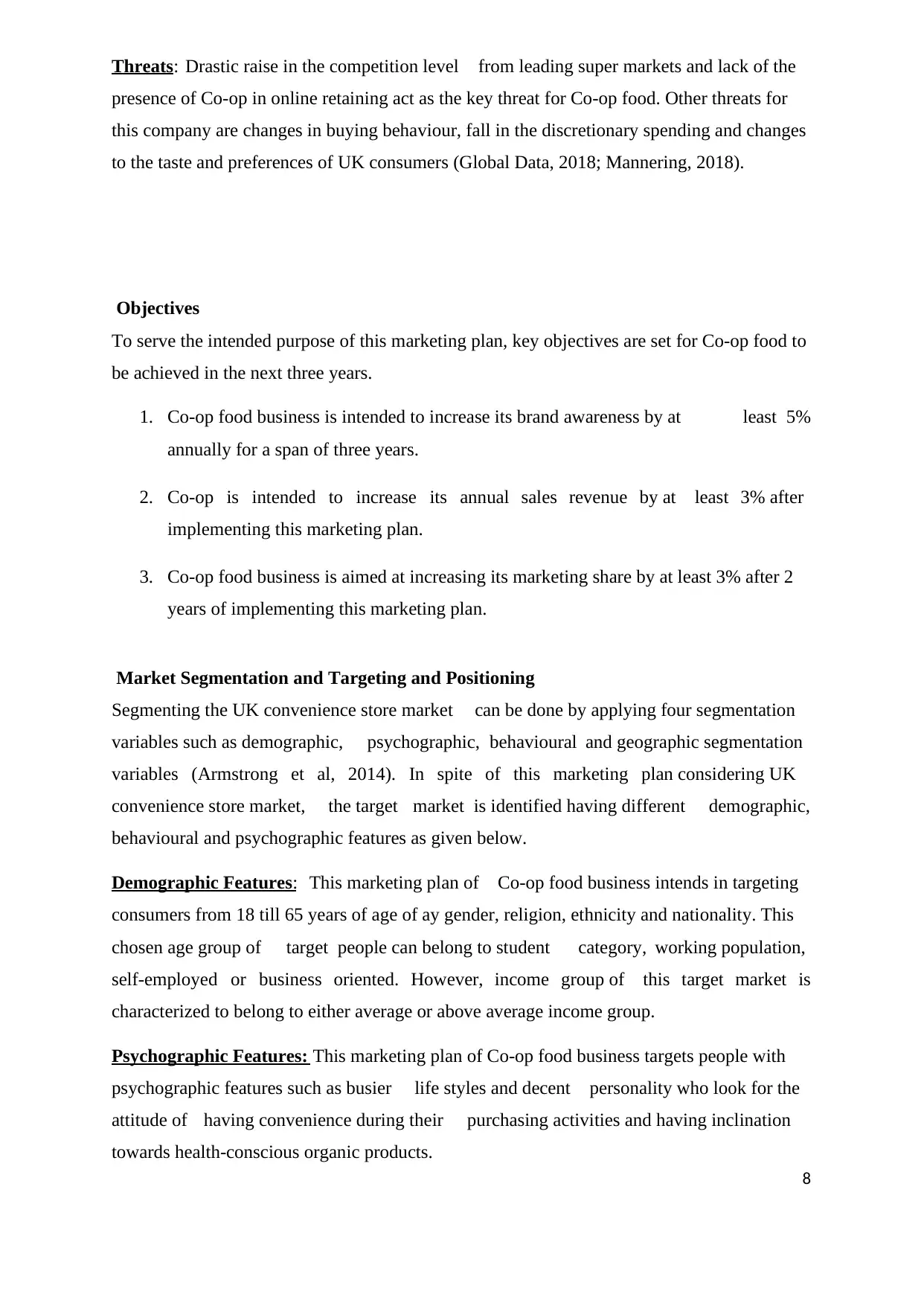
Threats: Drastic raise in the competition level from leading super markets and lack of the
presence of Co-op in online retaining act as the key threat for Co-op food. Other threats for
this company are changes in buying behaviour, fall in the discretionary spending and changes
to the taste and preferences of UK consumers (Global Data, 2018; Mannering, 2018).
Objectives
To serve the intended purpose of this marketing plan, key objectives are set for Co-op food to
be achieved in the next three years.
1. Co-op food business is intended to increase its brand awareness by at least 5%
annually for a span of three years.
2. Co-op is intended to increase its annual sales revenue by at least 3% after
implementing this marketing plan.
3. Co-op food business is aimed at increasing its marketing share by at least 3% after 2
years of implementing this marketing plan.
Market Segmentation and Targeting and Positioning
Segmenting the UK convenience store market can be done by applying four segmentation
variables such as demographic, psychographic, behavioural and geographic segmentation
variables (Armstrong et al, 2014). In spite of this marketing plan considering UK
convenience store market, the target market is identified having different demographic,
behavioural and psychographic features as given below.
Demographic Features: This marketing plan of Co-op food business intends in targeting
consumers from 18 till 65 years of age of ay gender, religion, ethnicity and nationality. This
chosen age group of target people can belong to student category, working population,
self-employed or business oriented. However, income group of this target market is
characterized to belong to either average or above average income group.
Psychographic Features: This marketing plan of Co-op food business targets people with
psychographic features such as busier life styles and decent personality who look for the
attitude of having convenience during their purchasing activities and having inclination
towards health-conscious organic products.
8
presence of Co-op in online retaining act as the key threat for Co-op food. Other threats for
this company are changes in buying behaviour, fall in the discretionary spending and changes
to the taste and preferences of UK consumers (Global Data, 2018; Mannering, 2018).
Objectives
To serve the intended purpose of this marketing plan, key objectives are set for Co-op food to
be achieved in the next three years.
1. Co-op food business is intended to increase its brand awareness by at least 5%
annually for a span of three years.
2. Co-op is intended to increase its annual sales revenue by at least 3% after
implementing this marketing plan.
3. Co-op food business is aimed at increasing its marketing share by at least 3% after 2
years of implementing this marketing plan.
Market Segmentation and Targeting and Positioning
Segmenting the UK convenience store market can be done by applying four segmentation
variables such as demographic, psychographic, behavioural and geographic segmentation
variables (Armstrong et al, 2014). In spite of this marketing plan considering UK
convenience store market, the target market is identified having different demographic,
behavioural and psychographic features as given below.
Demographic Features: This marketing plan of Co-op food business intends in targeting
consumers from 18 till 65 years of age of ay gender, religion, ethnicity and nationality. This
chosen age group of target people can belong to student category, working population,
self-employed or business oriented. However, income group of this target market is
characterized to belong to either average or above average income group.
Psychographic Features: This marketing plan of Co-op food business targets people with
psychographic features such as busier life styles and decent personality who look for the
attitude of having convenience during their purchasing activities and having inclination
towards health-conscious organic products.
8
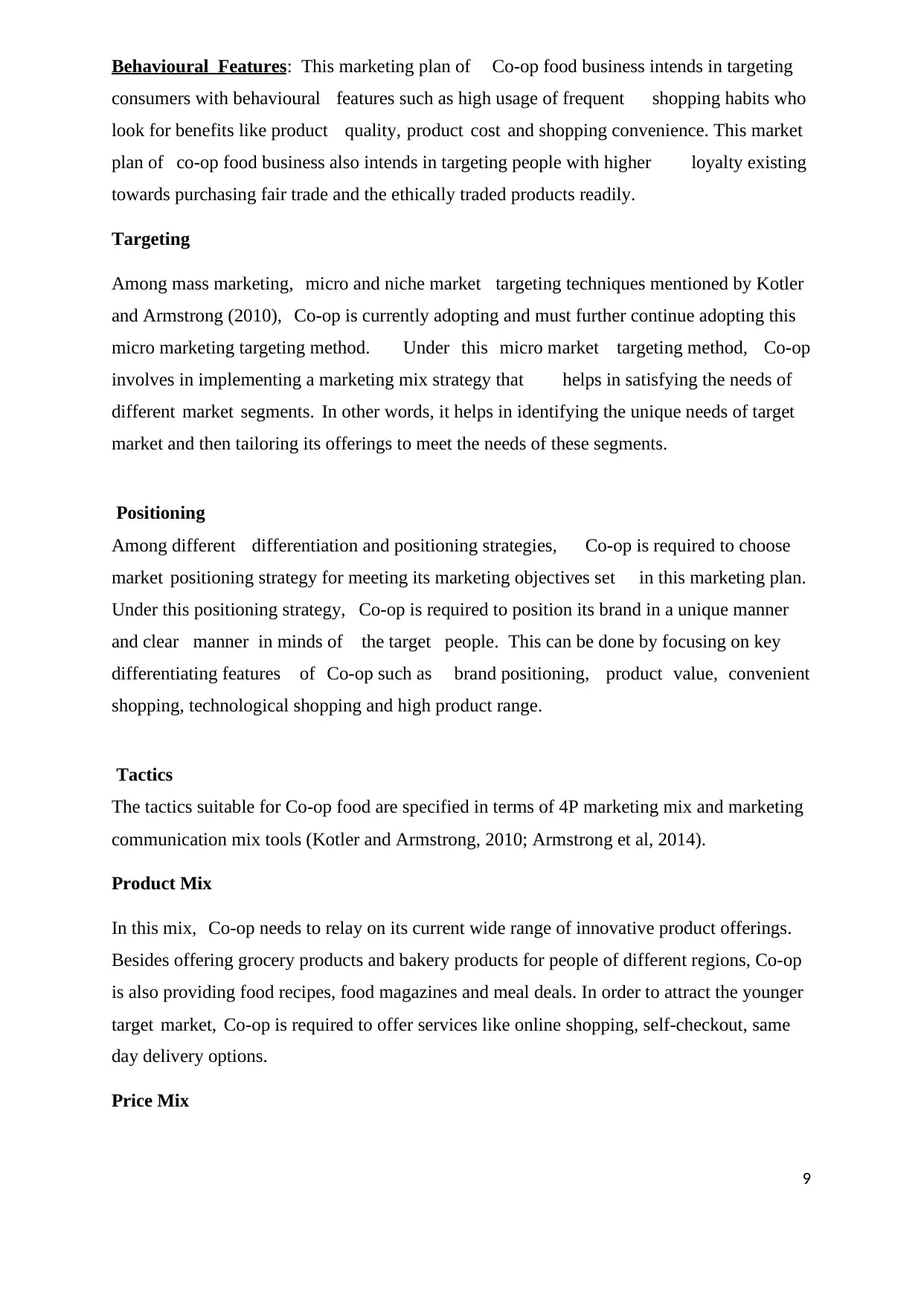
Behavioural Features: This marketing plan of Co-op food business intends in targeting
consumers with behavioural features such as high usage of frequent shopping habits who
look for benefits like product quality, product cost and shopping convenience. This market
plan of co-op food business also intends in targeting people with higher loyalty existing
towards purchasing fair trade and the ethically traded products readily.
Targeting
Among mass marketing, micro and niche market targeting techniques mentioned by Kotler
and Armstrong (2010), Co-op is currently adopting and must further continue adopting this
micro marketing targeting method. Under this micro market targeting method, Co-op
involves in implementing a marketing mix strategy that helps in satisfying the needs of
different market segments. In other words, it helps in identifying the unique needs of target
market and then tailoring its offerings to meet the needs of these segments.
Positioning
Among different differentiation and positioning strategies, Co-op is required to choose
market positioning strategy for meeting its marketing objectives set in this marketing plan.
Under this positioning strategy, Co-op is required to position its brand in a unique manner
and clear manner in minds of the target people. This can be done by focusing on key
differentiating features of Co-op such as brand positioning, product value, convenient
shopping, technological shopping and high product range.
Tactics
The tactics suitable for Co-op food are specified in terms of 4P marketing mix and marketing
communication mix tools (Kotler and Armstrong, 2010; Armstrong et al, 2014).
Product Mix
In this mix, Co-op needs to relay on its current wide range of innovative product offerings.
Besides offering grocery products and bakery products for people of different regions, Co-op
is also providing food recipes, food magazines and meal deals. In order to attract the younger
target market, Co-op is required to offer services like online shopping, self-checkout, same
day delivery options.
Price Mix
9
consumers with behavioural features such as high usage of frequent shopping habits who
look for benefits like product quality, product cost and shopping convenience. This market
plan of co-op food business also intends in targeting people with higher loyalty existing
towards purchasing fair trade and the ethically traded products readily.
Targeting
Among mass marketing, micro and niche market targeting techniques mentioned by Kotler
and Armstrong (2010), Co-op is currently adopting and must further continue adopting this
micro marketing targeting method. Under this micro market targeting method, Co-op
involves in implementing a marketing mix strategy that helps in satisfying the needs of
different market segments. In other words, it helps in identifying the unique needs of target
market and then tailoring its offerings to meet the needs of these segments.
Positioning
Among different differentiation and positioning strategies, Co-op is required to choose
market positioning strategy for meeting its marketing objectives set in this marketing plan.
Under this positioning strategy, Co-op is required to position its brand in a unique manner
and clear manner in minds of the target people. This can be done by focusing on key
differentiating features of Co-op such as brand positioning, product value, convenient
shopping, technological shopping and high product range.
Tactics
The tactics suitable for Co-op food are specified in terms of 4P marketing mix and marketing
communication mix tools (Kotler and Armstrong, 2010; Armstrong et al, 2014).
Product Mix
In this mix, Co-op needs to relay on its current wide range of innovative product offerings.
Besides offering grocery products and bakery products for people of different regions, Co-op
is also providing food recipes, food magazines and meal deals. In order to attract the younger
target market, Co-op is required to offer services like online shopping, self-checkout, same
day delivery options.
Price Mix
9
⊘ This is a preview!⊘
Do you want full access?
Subscribe today to unlock all pages.

Trusted by 1+ million students worldwide
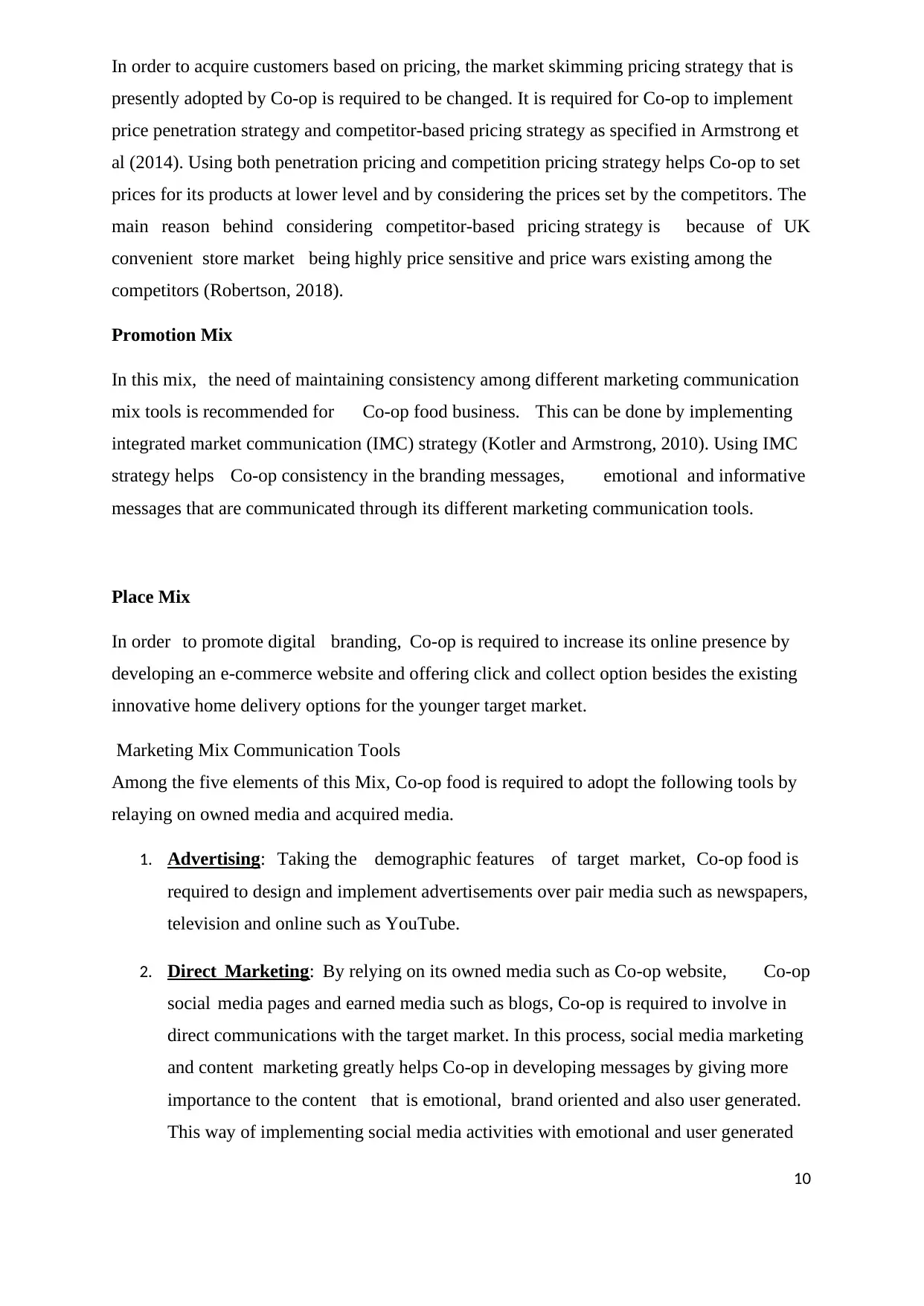
In order to acquire customers based on pricing, the market skimming pricing strategy that is
presently adopted by Co-op is required to be changed. It is required for Co-op to implement
price penetration strategy and competitor-based pricing strategy as specified in Armstrong et
al (2014). Using both penetration pricing and competition pricing strategy helps Co-op to set
prices for its products at lower level and by considering the prices set by the competitors. The
main reason behind considering competitor-based pricing strategy is because of UK
convenient store market being highly price sensitive and price wars existing among the
competitors (Robertson, 2018).
Promotion Mix
In this mix, the need of maintaining consistency among different marketing communication
mix tools is recommended for Co-op food business. This can be done by implementing
integrated market communication (IMC) strategy (Kotler and Armstrong, 2010). Using IMC
strategy helps Co-op consistency in the branding messages, emotional and informative
messages that are communicated through its different marketing communication tools.
Place Mix
In order to promote digital branding, Co-op is required to increase its online presence by
developing an e-commerce website and offering click and collect option besides the existing
innovative home delivery options for the younger target market.
Marketing Mix Communication Tools
Among the five elements of this Mix, Co-op food is required to adopt the following tools by
relaying on owned media and acquired media.
1. Advertising: Taking the demographic features of target market, Co-op food is
required to design and implement advertisements over pair media such as newspapers,
television and online such as YouTube.
2. Direct Marketing: By relying on its owned media such as Co-op website, Co-op
social media pages and earned media such as blogs, Co-op is required to involve in
direct communications with the target market. In this process, social media marketing
and content marketing greatly helps Co-op in developing messages by giving more
importance to the content that is emotional, brand oriented and also user generated.
This way of implementing social media activities with emotional and user generated
10
presently adopted by Co-op is required to be changed. It is required for Co-op to implement
price penetration strategy and competitor-based pricing strategy as specified in Armstrong et
al (2014). Using both penetration pricing and competition pricing strategy helps Co-op to set
prices for its products at lower level and by considering the prices set by the competitors. The
main reason behind considering competitor-based pricing strategy is because of UK
convenient store market being highly price sensitive and price wars existing among the
competitors (Robertson, 2018).
Promotion Mix
In this mix, the need of maintaining consistency among different marketing communication
mix tools is recommended for Co-op food business. This can be done by implementing
integrated market communication (IMC) strategy (Kotler and Armstrong, 2010). Using IMC
strategy helps Co-op consistency in the branding messages, emotional and informative
messages that are communicated through its different marketing communication tools.
Place Mix
In order to promote digital branding, Co-op is required to increase its online presence by
developing an e-commerce website and offering click and collect option besides the existing
innovative home delivery options for the younger target market.
Marketing Mix Communication Tools
Among the five elements of this Mix, Co-op food is required to adopt the following tools by
relaying on owned media and acquired media.
1. Advertising: Taking the demographic features of target market, Co-op food is
required to design and implement advertisements over pair media such as newspapers,
television and online such as YouTube.
2. Direct Marketing: By relying on its owned media such as Co-op website, Co-op
social media pages and earned media such as blogs, Co-op is required to involve in
direct communications with the target market. In this process, social media marketing
and content marketing greatly helps Co-op in developing messages by giving more
importance to the content that is emotional, brand oriented and also user generated.
This way of implementing social media activities with emotional and user generated
10
Paraphrase This Document
Need a fresh take? Get an instant paraphrase of this document with our AI Paraphraser
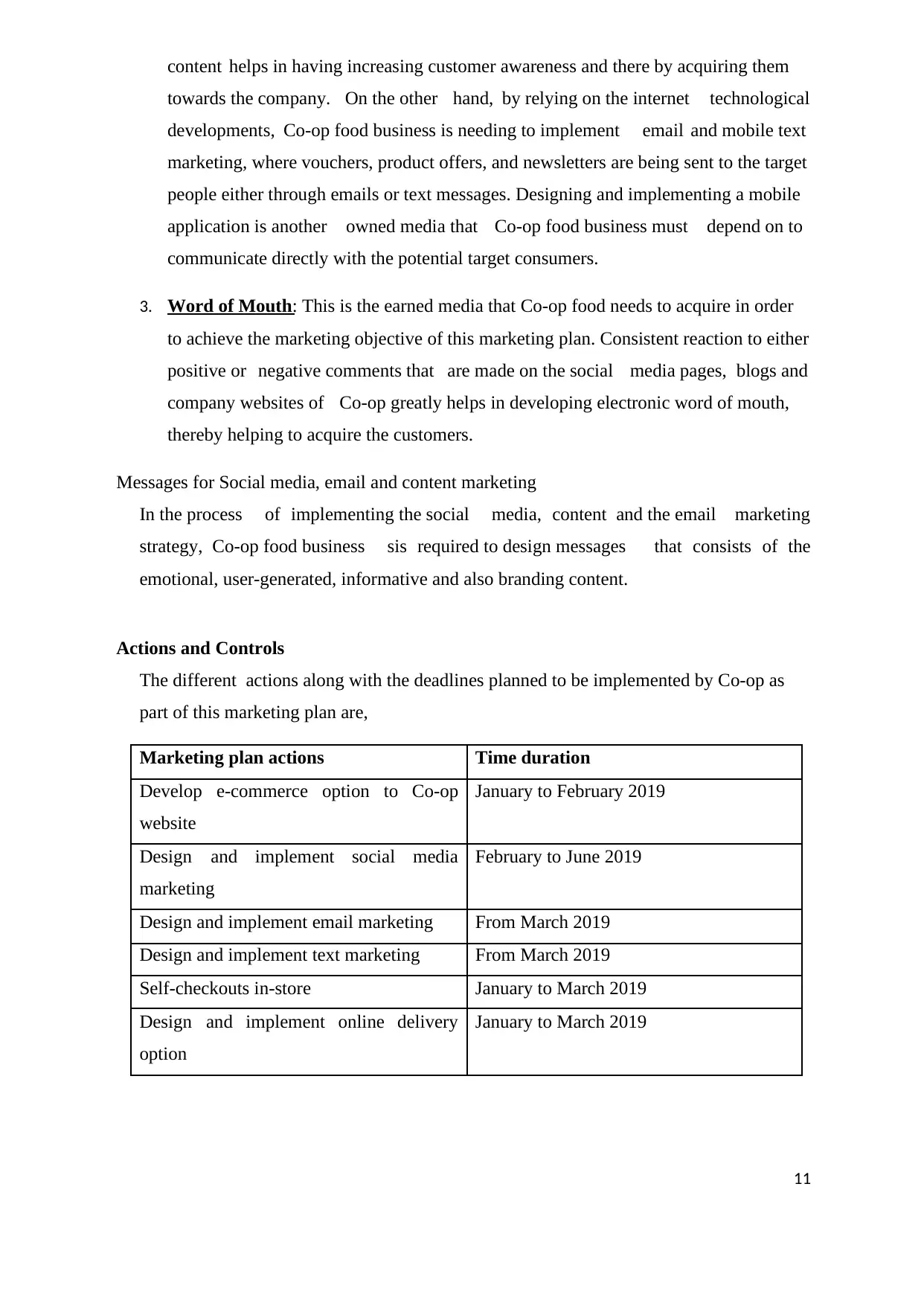
content helps in having increasing customer awareness and there by acquiring them
towards the company. On the other hand, by relying on the internet technological
developments, Co-op food business is needing to implement email and mobile text
marketing, where vouchers, product offers, and newsletters are being sent to the target
people either through emails or text messages. Designing and implementing a mobile
application is another owned media that Co-op food business must depend on to
communicate directly with the potential target consumers.
3. Word of Mouth: This is the earned media that Co-op food needs to acquire in order
to achieve the marketing objective of this marketing plan. Consistent reaction to either
positive or negative comments that are made on the social media pages, blogs and
company websites of Co-op greatly helps in developing electronic word of mouth,
thereby helping to acquire the customers.
Messages for Social media, email and content marketing
In the process of implementing the social media, content and the email marketing
strategy, Co-op food business sis required to design messages that consists of the
emotional, user-generated, informative and also branding content.
Actions and Controls
The different actions along with the deadlines planned to be implemented by Co-op as
part of this marketing plan are,
Marketing plan actions Time duration
Develop e-commerce option to Co-op
website
January to February 2019
Design and implement social media
marketing
February to June 2019
Design and implement email marketing From March 2019
Design and implement text marketing From March 2019
Self-checkouts in-store January to March 2019
Design and implement online delivery
option
January to March 2019
11
towards the company. On the other hand, by relying on the internet technological
developments, Co-op food business is needing to implement email and mobile text
marketing, where vouchers, product offers, and newsletters are being sent to the target
people either through emails or text messages. Designing and implementing a mobile
application is another owned media that Co-op food business must depend on to
communicate directly with the potential target consumers.
3. Word of Mouth: This is the earned media that Co-op food needs to acquire in order
to achieve the marketing objective of this marketing plan. Consistent reaction to either
positive or negative comments that are made on the social media pages, blogs and
company websites of Co-op greatly helps in developing electronic word of mouth,
thereby helping to acquire the customers.
Messages for Social media, email and content marketing
In the process of implementing the social media, content and the email marketing
strategy, Co-op food business sis required to design messages that consists of the
emotional, user-generated, informative and also branding content.
Actions and Controls
The different actions along with the deadlines planned to be implemented by Co-op as
part of this marketing plan are,
Marketing plan actions Time duration
Develop e-commerce option to Co-op
website
January to February 2019
Design and implement social media
marketing
February to June 2019
Design and implement email marketing From March 2019
Design and implement text marketing From March 2019
Self-checkouts in-store January to March 2019
Design and implement online delivery
option
January to March 2019
11
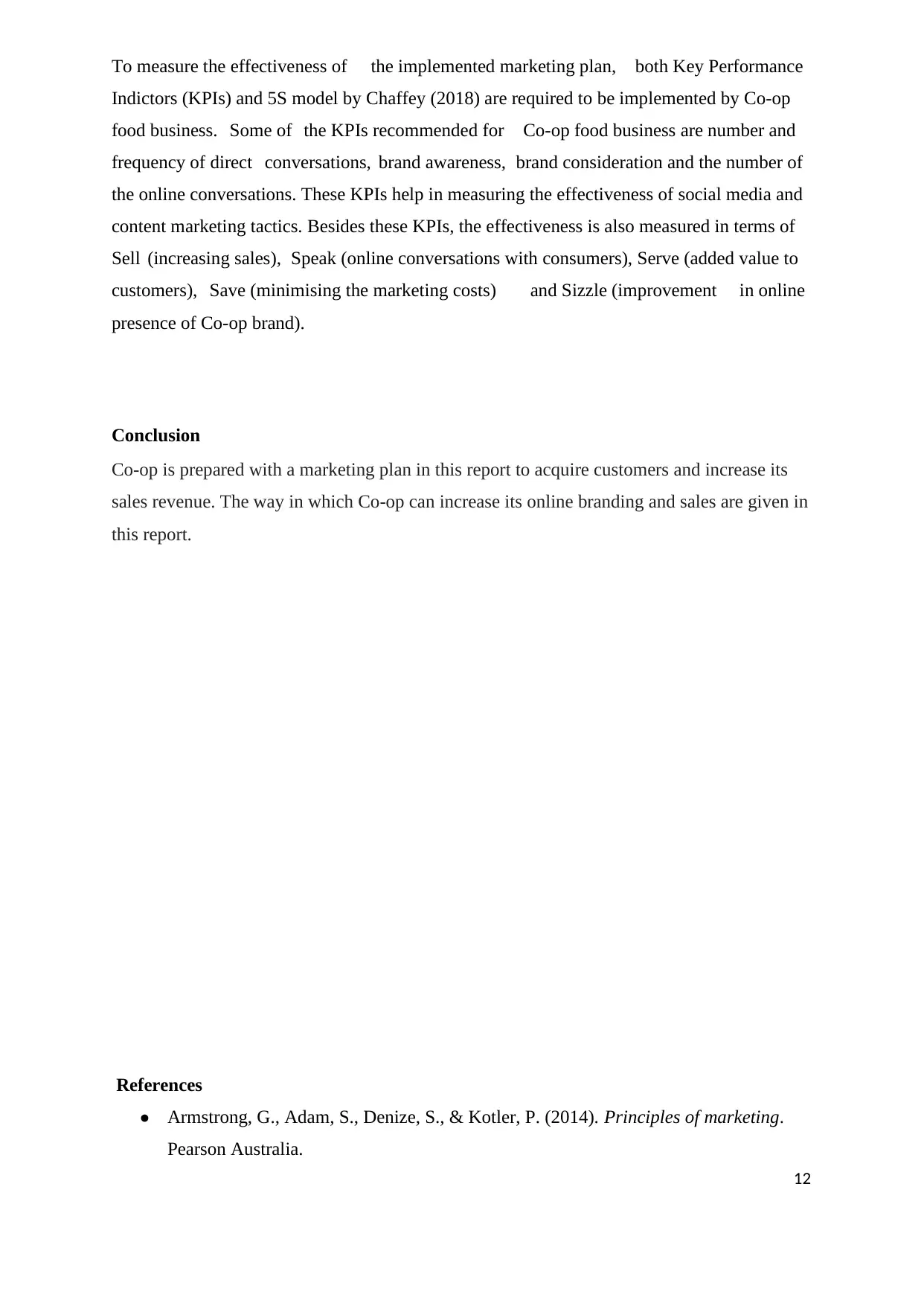
To measure the effectiveness of the implemented marketing plan, both Key Performance
Indictors (KPIs) and 5S model by Chaffey (2018) are required to be implemented by Co-op
food business. Some of the KPIs recommended for Co-op food business are number and
frequency of direct conversations, brand awareness, brand consideration and the number of
the online conversations. These KPIs help in measuring the effectiveness of social media and
content marketing tactics. Besides these KPIs, the effectiveness is also measured in terms of
Sell (increasing sales), Speak (online conversations with consumers), Serve (added value to
customers), Save (minimising the marketing costs) and Sizzle (improvement in online
presence of Co-op brand).
Conclusion
Co-op is prepared with a marketing plan in this report to acquire customers and increase its
sales revenue. The way in which Co-op can increase its online branding and sales are given in
this report.
References
● Armstrong, G., Adam, S., Denize, S., & Kotler, P. (2014). Principles of marketing.
Pearson Australia.
12
Indictors (KPIs) and 5S model by Chaffey (2018) are required to be implemented by Co-op
food business. Some of the KPIs recommended for Co-op food business are number and
frequency of direct conversations, brand awareness, brand consideration and the number of
the online conversations. These KPIs help in measuring the effectiveness of social media and
content marketing tactics. Besides these KPIs, the effectiveness is also measured in terms of
Sell (increasing sales), Speak (online conversations with consumers), Serve (added value to
customers), Save (minimising the marketing costs) and Sizzle (improvement in online
presence of Co-op brand).
Conclusion
Co-op is prepared with a marketing plan in this report to acquire customers and increase its
sales revenue. The way in which Co-op can increase its online branding and sales are given in
this report.
References
● Armstrong, G., Adam, S., Denize, S., & Kotler, P. (2014). Principles of marketing.
Pearson Australia.
12
⊘ This is a preview!⊘
Do you want full access?
Subscribe today to unlock all pages.

Trusted by 1+ million students worldwide
1 out of 15
Related Documents
Your All-in-One AI-Powered Toolkit for Academic Success.
+13062052269
info@desklib.com
Available 24*7 on WhatsApp / Email
![[object Object]](/_next/static/media/star-bottom.7253800d.svg)
Unlock your academic potential
Copyright © 2020–2025 A2Z Services. All Rights Reserved. Developed and managed by ZUCOL.





